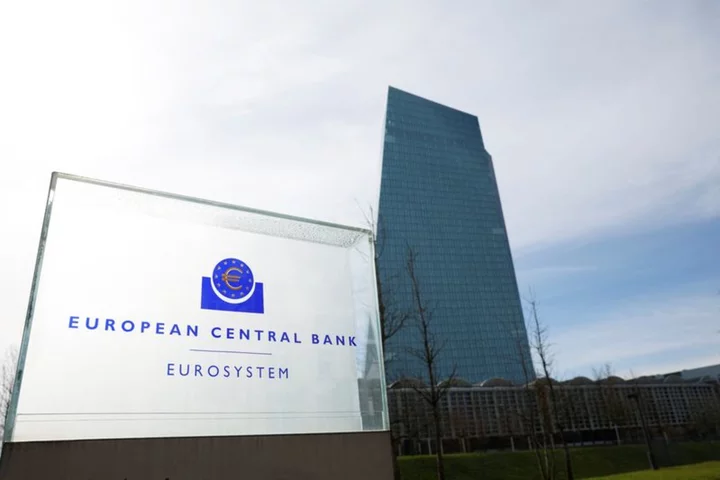By Yoruk Bahceli
(Reuters) -Traders on Wednesday firmed up bets that the European Central Bank would pause hiking interest rates in September, as sharp contractions in business activity pointed to deepening economic pain in Europe.
Traders now price in a roughly 40% chance of a 25 basis point move in September compared with a more than 50% chance they saw only on Tuesday.
That suggests they are leaning towards a pause in the ECB's record-paced tightening cycle that has lifted rates from deep in negative territory to 3.75% in just a year.
German business activity contracted at the fastest pace in over three years in August and much more than analysts expected, data showed on Wednesday, deepening the downturn in business activity far more than thought across the euro zone. Britain's business activity meanwhile contracted unexpectedly, raising recession risks.
Bond yields in the euro zone and Britain, recently propped up by a resilient U.S. economy, tumbled. The euro fell to more than a two-month low against the dollar and sterling dropped sharply as investors also scaled back their expectations for where ECB and Bank of England rates will peak.
"The PMI suggests that it's back to the pre-summer narrative of lower rates," said Danske Bank chief analyst Piet Christiansen.
Germany's 10-year Bund yield, the benchmark for the euro area, dropped as much as 13 basis points to 2.52%, the lowest since Aug. 10. Two-year German yields, sensitive to interest rate expectations, dropped similarly below 3%.
Hit by the receding rate hike expectations, the euro fell to as low as $1.0804, extending its losses against the dollar this month to 1.7%. It is set for its biggest monthly drop since May.
DIVERGING FORTUNES
In Britain, gilt yields were over 10 bps lower on the day across the yield curve and sterling dropped as much as 0.9% against the dollar.
Just last week, 10-year gilt yields had hit their highest levels since 2008 just above 4.7%.
Wednesday's sharp falls in borrowing costs highlight how Europe's weaker economy and outlook for borrowing costs diverges from resilience in the U.S. Strong U.S. data this month has prompted expectations that interest rates will remain higher for longer.
That sent U.S. Treasury yields to their highest in over a decade and lifted borrowing costs higher globally, with Germany's 10-year yield rising earlier in August to 2.72%, its highest since March.
Highlighting the contrast in outlooks, U.S. Treasury yields dropped by much less than in Europe on Wednesday and traded with the highest yield relative to Germany's since December at 173 bps, a headwind to the euro.
"The dovish case that high inflation is not the result of excess demand, but rather the result of exogenous shocks and therefore a contributor to weak growth, is strengthened by the PMI data," Citi economists said in a note to clients.
"Today’s PMI release reduces the chances of a September rate hike (our base case) and increases the chance that rate cuts will come earlier than most Governing Council members thought," they added.
JPMorgan now expects the ECB to pause in September and has postponed its expectation of a final 25 bps hike to October, joining a narrow majority of economists polled by Reuters earlier in August who also expect a September pause.
While expectations were scaled back, traders still expect two more 25 bps rate hikes from the BoE, which is tackling higher inflation than the euro zone. They also still see just under a 60% chance of a 25 bps ECB rate hike by December.
Key to investor expectations from the ECB will be next week's euro zone inflation data.
"There's many indicators that suggest that we could have had the last hike but if you just look at inflation, which is the (ECB's) key mandate... that is not a done deal," Christiansen at Danske Bank said.
(Reporting by Yoruk Bahceli and Samuel Indyk, additional reporting by Stefano Rebaudo; editing by Dhara Ranasinghe, Tomasz Janowski, William Maclean)

